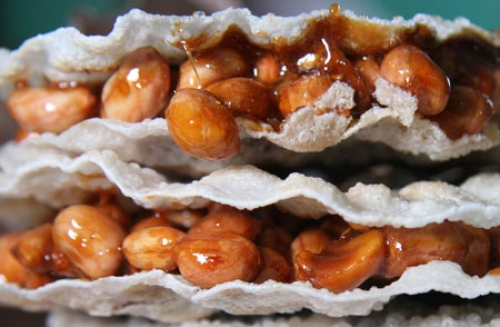Kẹo Cu-đơ is made from natural ingredients such as: peanut, cane molasses, malt powder, sesame, and ginger. Candied peanut is itself delicious. Kẹo Cu-đơ (peanut rice-paper candy) is a famous food of the central province of Ha Tinh.
In Vietnamese kẹo means candy, and Cu-đơ is the nickname locals gave the man who changed the traditional form of making candy. People snicker while eating it because Cu-đơ is a play on “stiff penis.”
In the past it used to be called just kẹo lạc (peanut candy).
Cu-đơ was a seller of peanut candy and green tea who had the novel idea of putting rice paper under the peanut candy instead of wax paper that was used traditionally to prevent the candy from sticking.
This clever idea meant the crispy rice cracker made the candy even tastier.
Kẹo Cu-đơ is made from natural ingredients like peanut, cane molasses, malt powder, sesame, and ginger.
The process may seem simple but it is not really so, and one has to strictly follow it to achieve the right taste.
For delicious kẹo Cu-đơ, one needs pure cane molasses. If the molasses is not pure and is mixed with sugar, the peanut will not taste as good, spoil easily, and it will melt in hot weather.
Put cane molasses in a pot on the stove. Cook until it melts and starts bubbling. Add ginger, sesame, and malt powder to soften the molasses.
Stir the mixture constantly. When it is bubbling, add the peanut to the pot. If the peanut is added at the right time, it will be crispy and fragrant and melt in the mouth.
Stir it one direction, otherwise the skin will peel off or the nuts will sink to the bottom and burn, making the kẹo Cu-đơ bitter.
When the mixture is done, pour it between two grilled rice papers.
The candy must be not too thin or thick.
Five or ten of them are put together in an airtight nylon bag to keep them fresh and crispy.
Kẹo Cu-đơ is perfect when it has the sweet taste of cane molasses,crispiness of the rice paper, and greasy, the pungency and slight spiciness of ginger, buttery taste of peanut. It is a popular dish when served with hot green tea.
Source: Thanh Nien New






































































































